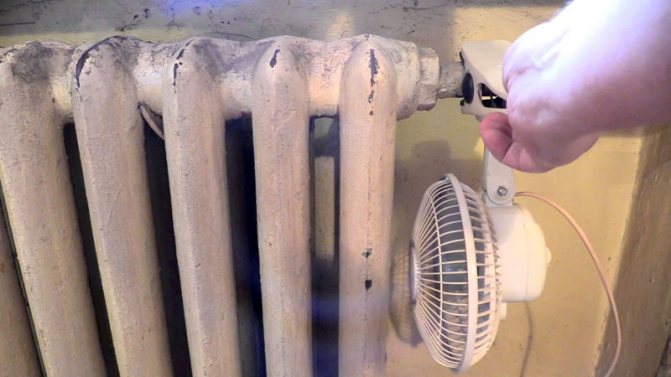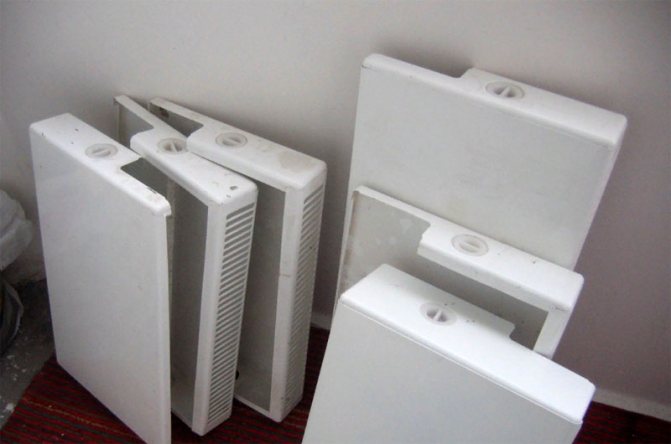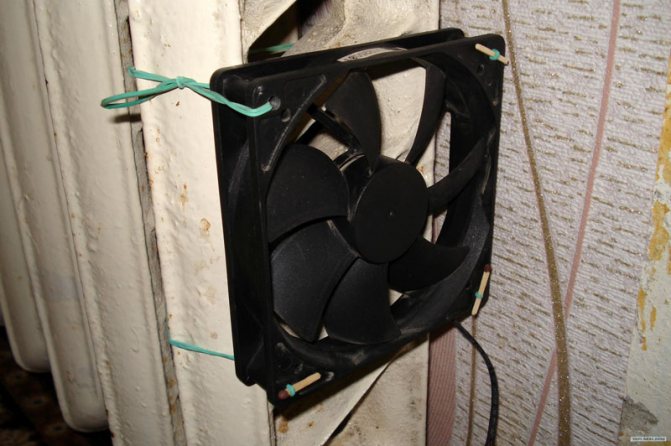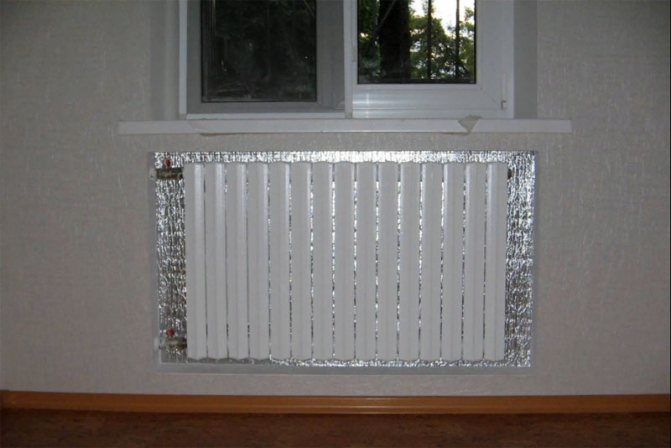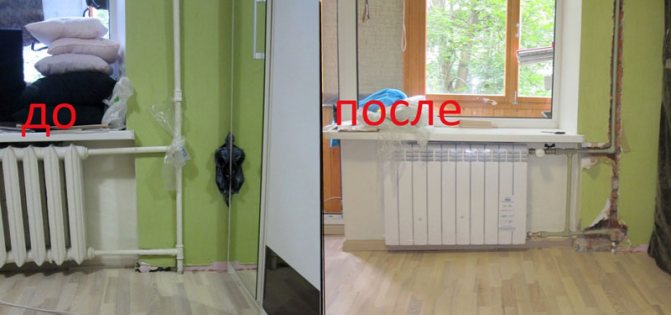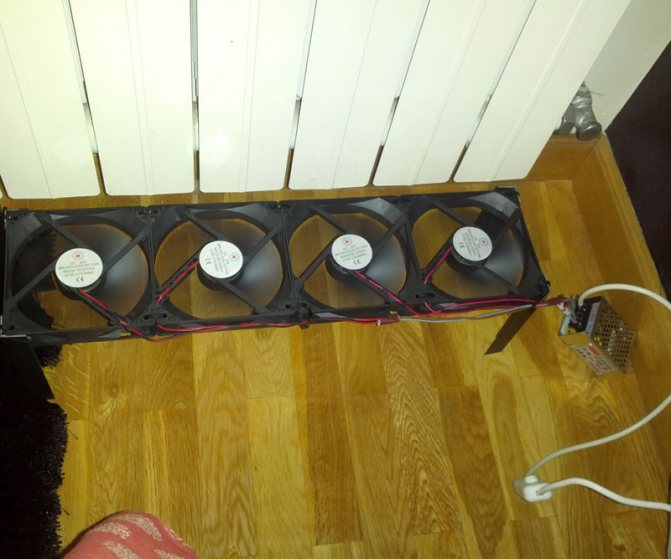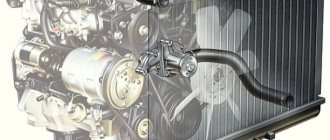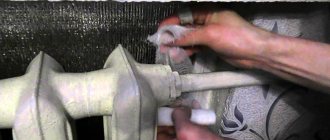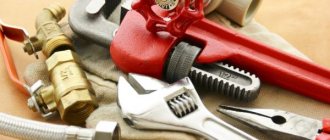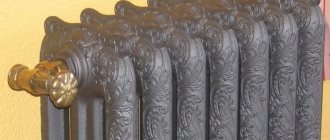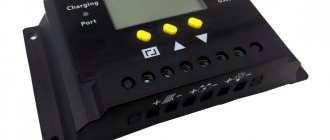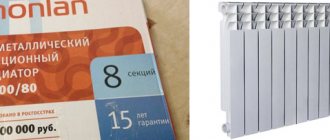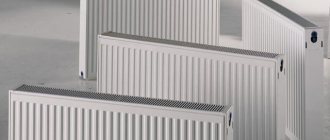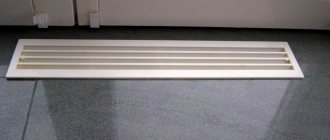The device or reconstruction of the heating system implies the installation or replacement of heating devices. The good news is that if you want, you can do it yourself without involving specialists. How the installation of heating radiators should take place, where and how to place them, what is needed to carry out the work - all this is in the article.
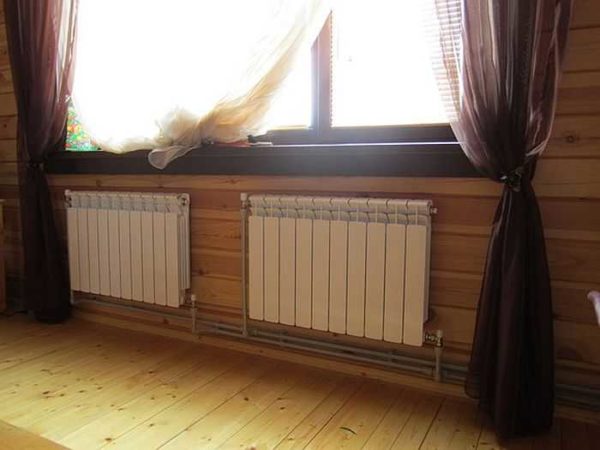
Do-it-yourself installation of heating radiators is possible
What is needed for installation
Installation of heating radiators of any type requires devices and consumables. The set of necessary materials is almost the same, but for cast-iron batteries, for example, the plugs are large, and the Mayevsky valve is not installed, but, somewhere at the highest point of the system, an automatic air vent is installed. But the installation of aluminum and bimetallic radiators is absolutely the same.
Steel panel ones also have some differences, but only in terms of hanging - brackets are included with them, and on the rear panel there are special bows cast from metal, with which the heater clings to the hooks of the brackets.
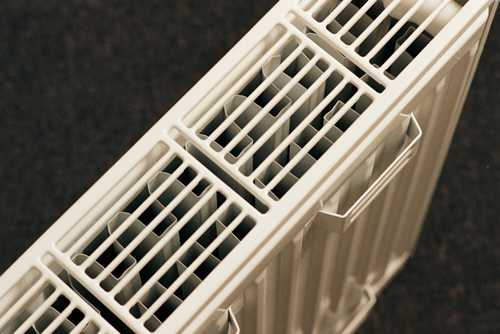

Hooks are set for these bows
Mayevsky crane or automatic air vent
This is a small venting device for air that can collect in the radiator. Placed on a free top outlet (collector). Must be on every heating device when installing aluminum and bimetallic radiators. The size of this device is much less than the diameter of the collector, so an adapter is also required, but Mayevsky taps usually come complete with adapters, you just need to know the diameter of the collector (connecting dimensions).


Mayevsky's crane and how to install it
In addition to the Mayevsky crane, there are also automatic air vents. They can also be placed on radiators, but they are slightly larger and for some reason are only available in a brass or nickel-plated case. Not in white enamel. In general, the picture turns out to be unattractive and, although they deflate automatically, they are rarely put on.
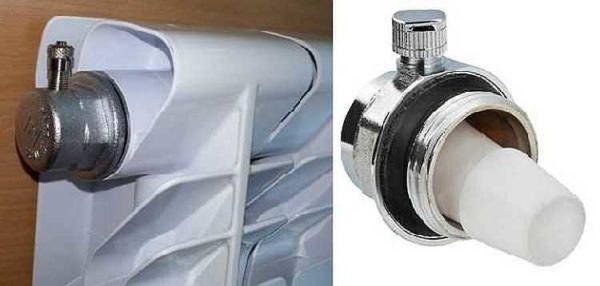

This is what a compact automatic air vent looks like (there are more bulky models)
Plug
The radiator has four outputs with side connection. Two of them are occupied by the supply and return pipelines, on the third they are installing a Mayevsky crane. The fourth entrance is closed with a plug. She, like most modern batteries, is most often painted with white enamel and does not spoil the appearance at all.


Where to put the plug and the Mayevsky tap with different connection methods
Shut-off valves
You will need two more ball valves or shut-off valves with the ability to adjust. They are placed on each input and output battery. If these are ordinary ball valves, they are needed so that, if necessary, you can turn off the radiator and remove it (emergency repair, replacement during the heating season). In this case, even if something happened to the radiator, you cut it off, and the rest of the system will work. The plus of this solution is the low price of ball valves, minus the impossibility of adjusting the heat transfer.


Heating radiator taps
Almost the same tasks, but with the ability to change the intensity of the coolant flow, are performed by shut-off control valves. They are more expensive, but they also allow you to adjust the heat transfer (to make it less), and they look better outwardly, they are available in a straight and angled version, so the strapping itself is more accurate.
If desired, you can put a thermostat on the coolant supply after the ball valve.This is a relatively small device that allows you to change the heat transfer of the heater. If the radiator does not heat well, they cannot be installed - it will be even worse, since they can only make less flow. There are different thermostats for batteries - automatic electronic, but more often they use the simplest - mechanical.
Related materials and tools
You will also need hooks or brackets for hanging on walls. Their number depends on the size of the batteries:
- if the sections are not more than 8 or the length of the radiator is not more than 1.2 m, two attachment points at the top and one at the bottom are sufficient;
- for every next 50 cm or 5-6 sections add one fastener at the top and bottom.
So you need fum tape or linen roll, plumbing paste to seal the joints. You will also need a drill with drills, a level (a level is better, but a regular bubble level is also suitable), a certain number of dowels. You will also need equipment for connecting pipes and fittings, but it depends on the type of pipes. That's all.
How to change central heating batteries in an apartment
With the approach of the new heating season, the issue of heating apartments again becomes relevant. To thoroughly prepare for the arrival of cold weather, many change batteries to more advanced models. The columnist for "RIAMO in Podolsk" found out who should pay for the repairs and what to do in case of a leak.
Illegal extortions of the Criminal Code: what to do and where to go in Podolsk >>
At whose expense the batteries are changed
Privatized housing
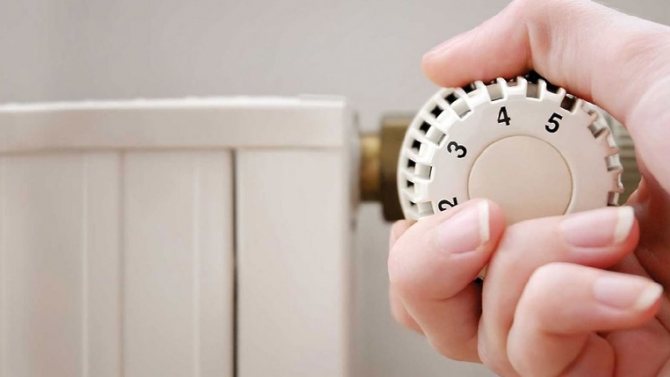

Official website of the administration of the city of Korolev
According to the Housing Code of the Russian Federation, walls, roofs and transit communications (including batteries) in privatized apartments are common property. Therefore, the management company bears financial responsibility for their condition, and homeowners are not obliged to pay for the replacement of worn out radiators. However, the radiator ceases to be considered a common property if it can be separated from the riser using a shut-off device.
Before changing the batteries, you need to check if there is a tap on the branch from the riser of the in-house heating system that disconnects the batteries. If it is not there, then you can contact the management company for a free replacement of radiators. Owners can also collectively decide to replace batteries at an additional cost - a condition usually specified in the management contract.
How can retirees get compensation for faulty batteries >>
Housing on social rent
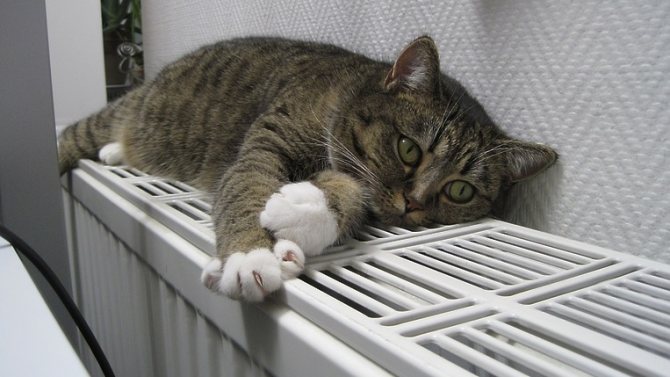

© pixabay.com, Goergl
A tenant renting housing from the state falls under the "Rules for the maintenance of common property in an apartment building", in which the common property also includes an in-house heating system, including risers, heating elements and valves regulating them, as well as other equipment on these networks. Therefore, the repair and replacement of batteries must be paid for by the management company from the funds accrued under the item "Routine repairs and maintenance of the house", with the exception of work performed as part of the overhaul of the heating system of the house as a whole.
If the radiator does not have a shut-off valve, tenants do not have to pay for the purchase or replacement of the radiator. If there is one, then the replacement of heating batteries in the apartment will relate to the current repair, and, according to the social contract, it is carried out at the expense of the employer. So, the tenant is obliged to monitor the serviceability and safety of the equipment inside the apartment and make current repairs of the premises at his own expense.
Where to go if you have not turned on the heating >>
Legislative subtleties


State Housing Inspection website
The law limits the ability of a tenant or apartment owner to replace radiators on their own.According to Articles 44 and 46 of the Housing Code of the Russian Federation, the battery as part of the common share property can be replaced only by the decision of all equity holders at the general meeting. Otherwise, the replacement of pipes and heating batteries in the apartment will be an unauthorized disposal of the common house property, and the violator of the rules will be personally liable in the event of an accident in the heating system.
Homeowners' association requires to coordinate with them the installation of an additional heating element in the apartment or change its configuration. Such actions are considered re-equipment of the heating system, so the corresponding notes must be entered in the technical passport of the room. In most cases, battery replacement is not reflected in the data sheet.
Tips from Podol residents: how to wait for the heating to turn on and not freeze >>
Reasons for replacing batteries
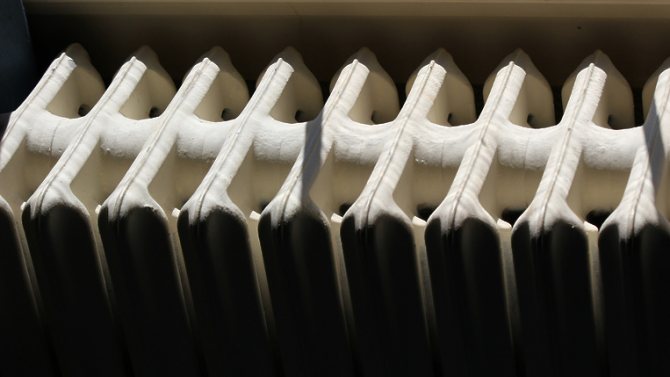

© flickr.com, GollyGforce - Living My Worst Nightmare
According to current regulations, the service life of cast iron batteries is 15-30 years (open heating systems) and 30-40 years (closed systems). Replacement of heating devices is classified as a major overhaul.
Replacing heating radiators through the UK is possible only if the heating devices are out of order and their operational life has been exceeded. In all other situations, the operating company only carries out minor repairs.
How to pay for housing and communal services in the Moscow region remotely >>
When the batteries are changed
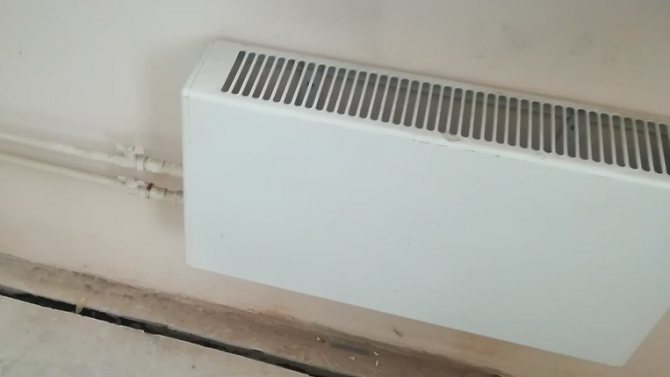

Pavel Maksimovich's Vkontakte page
The heating batteries in the apartment are changed if possible in the summer or until the heating is turned on. However, in this case, it is impossible to immediately check how well the work is done. If the heating is turned on suddenly, and the owner of the apartment is not at home, then the system may leak, and it will take a lot of effort to eliminate the consequences.
Replacing batteries during the period when heating is turned on is complicated by the fact that during the work it will be necessary to turn off the heating in all apartments connected by one riser. But this is only if the batteries in the apartment are not turned off by a tap.
What awaits Podol residents after the VAT increase in 2020: expert opinion >>
How to write a statement


© RIAMO, Anastasia Osipova
If the central heating batteries in the apartment require replacement and there is no jumper on them, then you can write an official letter to the organization serving the house with the requirement to change the batteries in two copies, on one of them ask to make a note about registration. It is necessary to make sure that the incoming number, date and legible signature of the person who accepted the application is displayed. You can also send a certified letter by mail with notification.
Applications are submitted to the Criminal Code for the replacement of heating devices and for disconnecting the riser and removing water. If the first appeal is submitted with the aim of obtaining the principal approval of the replacement and determination with the terms, then the second is already directly for the performance of work.
What has changed for summer residents after the adoption of the law on unauthorized buildings >>
If the UK does not want to change the batteries


Ministry of Ecology and Nature Management of the Moscow Region
It is worth reminding the representatives of the Criminal Code that if the battery breaks through, then compensation for material damage will be entrusted to the service company.
The management company, in response to a request to replace the central heating batteries in the apartment, can refer to the clause on the balance differentiation of common house and private property, according to which the owner himself is responsible for the repair and maintenance of batteries. But contradictions in the law do not cancel the main provision, which classifies heating radiators as common property. You need to be prepared for the fact that you will have to defend your case in court.
Problematic new building on Kolkhoznaya: poor heating and a ghost floor >>
How to change batteries yourself
Battery selection
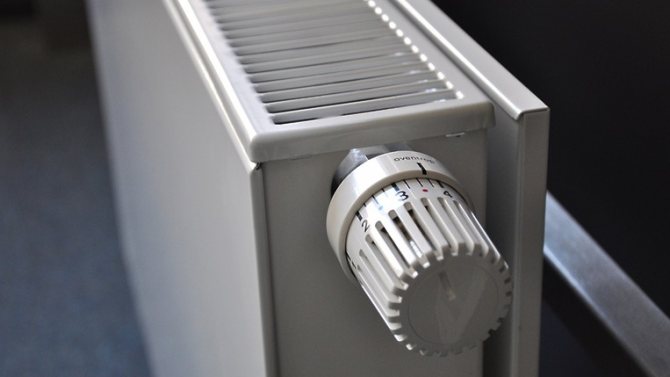

© pixabay.com, ri
The number of heating devices: one section should fall on 2 square meters of housing and additionally one more section for the entire area of the room.
The amount of heat required to heat a room: 34 W of thermal energy should fall on 1 cubic meter in a brick house, 41 W in a panel building, and 20 W in a new building. Based on this, the required amount of heat for the room is determined.
Mostly steel and cast iron radiators are installed, which are suitable for central heating of multi-storey buildings. The material has high heat transfer, is resistant to temperature and pressure drops, as well as aggressive environment. Relatively recently, bimetallic radiators have appeared on the market, which in their characteristics practically do not differ from monometallic heating devices, but outwardly more attractive.
Methods for calculating payment for heating in the Moscow region >>
UK notification
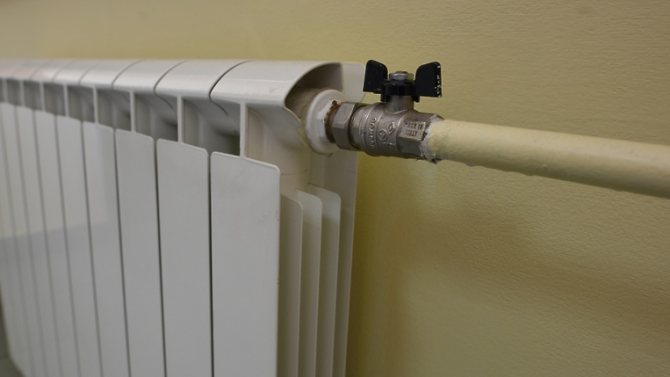

Alexander Kozhokhin
When replacing radiators in an apartment on your own, as well as when moving them to another place, the organization serving the house should be notified.


How to legally deal with negligent neighbors
If the replacement is carried out for similar structures, it is enough just to provide information about the upcoming installation work.
Radiators of a different model will be installed, which may lead to an increase in the heating area? The representatives of the management company will carry out an examination in order to find out the possibility of changes in the heat balance of the building. The master will inspect the area of the house, new batteries, and study their technical data.
Also, an examination is carried out in the case when a major overhaul of an apartment involves a change in the configuration of the pipeline.
What to do with inherited debts: expert advice >>
Getting permission


© Photobank of the Moscow Region, Anastasia Osipova
By law, additional installation of heating devices must be agreed with the administration of the operating organization. Since the heating system is calculated individually for each house (the number of connected devices, temperature and volume of the coolant, rated power), if the work is not coordinated, the quality of heating may decrease.


How to pay for housing and communal services in Podolsk: MosOblEIRTS and new opportunities
To obtain a replacement permit, you need to write an application, attach a technical passport for the apartment and a certificate of ownership, thermal calculation of new heating elements, certificates of conformity for all components (valves, pipes, fittings, radiators, etc.).
It may take 2 months to review the documents and issue a permit. You will also need to additionally write a statement about the need to drain from the pipelines and disconnect the riser. After the heating radiators are replaced, you will need to write an application for a technical examination.
How to get rid of insects in an apartment: popular and effective ways >>
Battery replacement
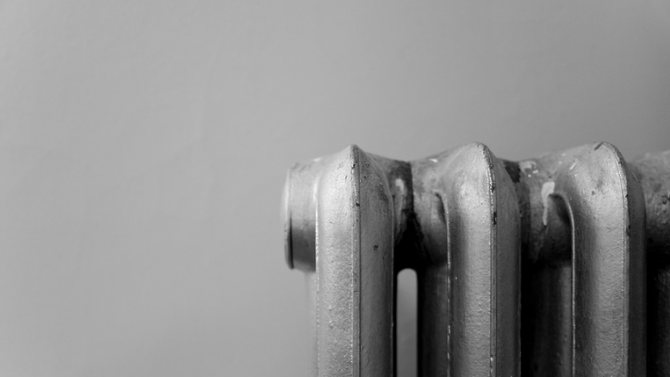

© flickr.com, Jason Pier in DC
First, dismantle the old radiator. To do this, you need to untwist the threaded connection or cut the welding with a grinder. Next, the fitting and canopy of the new heater is carried out. It is important to correctly align the vertical and horizontal lines, to exclude possible distortions and other defects.
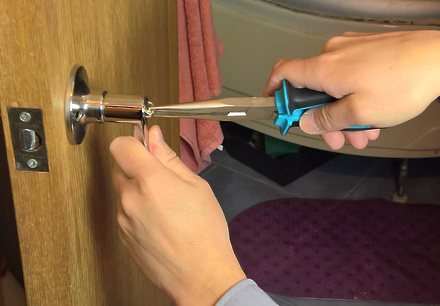

How to disassemble and repair a door latch?
To properly replace heating radiators in an apartment, you must use the building level. For high-quality and maximum efficient operation of the system, it is necessary to prepare ball valves, plugs, Mayevsky valves and installation of bypasses. Using special tools, the riser is threaded when the battery is connected to the riser.
In order to avoid rupture of the heater and water hammer during pressure testing, it is necessary to close the air release valve and all shut-off valves.Wait until the coolant fills the system and the pipes become hot. Then slowly open the shut-off valves, carefully unscrew the air valve head and keep it open until water appears. This means that the radiator is completely filled with water and there is no air lock. As soon as water appears, the valve must be closed.
As a rule, such work is performed for a separate fee by the employees of the management company under a separate contract.
What to do if a homeless person settled in the entrance of the house >>
If the batteries are leaking
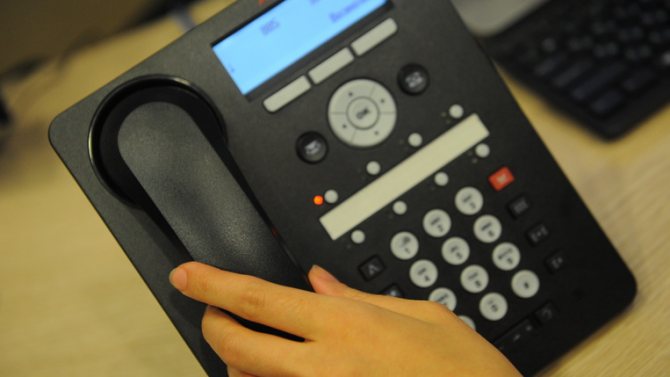

© Photobank of the Moscow Region, Alexander Kozhokhin
If during the heating season one or several batteries leak, then this is a pre-emergency situation, since the water is in the system under pressure, which is fraught with the flooding of apartments along the riser.
Having discovered a leak, the owner of the apartment must, without wasting a minute, notify the service organization. The management company, HOA, housing office or other service company is obliged to respond immediately and eliminate the problem, preventing a larger-scale accident.
After that, the management company is obliged to replace the leaky radiator with a new one.
Where and how to place
Traditionally, heating radiators are installed under the window. This is necessary so that the rising warm air cuts off the cold from the window. To prevent the glass from sweating, the width of the heater must be at least 70-75% of the window width. It must be installed:
- in the middle of the window opening, the permissible deviation is 2 cm;
- the distance from the radiator to the floor is 8-12 cm;
- to the windowsill - 10-12 cm;
- from the back wall to the wall - 2-5 cm.
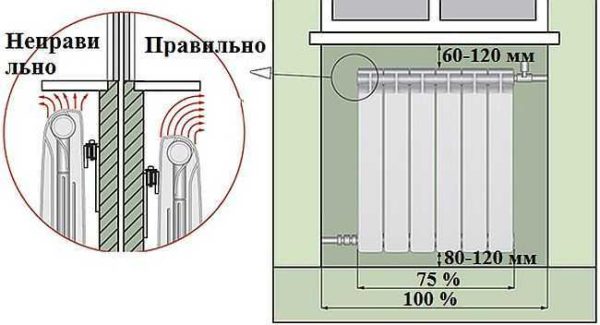

Distances from the heating radiator to the window
These are all recommendations, the observance of which ensures the normal circulation of warm air in the room and its effective heating.
How to install correctly
Now how to hang a radiator. It is highly desirable that the wall behind the radiator is level - it is easier to work this way. The middle of the opening is marked on the wall, a horizontal line is drawn 10-12 cm below the window sill line. This is the line along which the upper edge of the heater is aligned. The brackets must be installed so that the top edge coincides with the drawn line, that is, it is horizontal. This arrangement is suitable for forced circulation heating systems (with a pump) or for apartments. For systems with natural circulation, a slight slope is made - 1-1.5% - along the flow of the coolant. You can't do more - there will be stagnation.
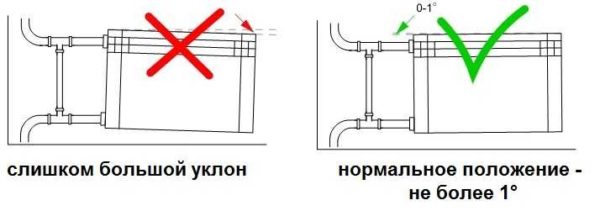

Correct installation of heating radiators
Wall mount
This must be taken into account when installing hooks or brackets for heating radiators. Hooks are installed like dowels - a hole of a suitable diameter is drilled in the wall, a plastic dowel is installed in it, and the hook is screwed into it. The distance from the wall to the heater can be easily adjusted by twisting and unscrewing the hook body.
How to properly connect a bimetallic radiator?
Very often, and in the fall almost every day, on the most popular forum on the Russian Internet on the installation topic mastergrad.com, topics or messages appear with a question about the problems of connecting bimetallic radiators in apartments and I am very sorry that in our time, when there is access to any information in network, a lot of people are faced with this problem, turning to "specialists" to replace radiators, who do not have the slightest idea about how this installation is performed. And the question is not only that the radiators do not completely or completely do not warm up, which casts doubt on the advisability of such a replacement, but also that the installation is also often carried out with serious violations of the design conditions of the heating system, which seriously affect its reliability, thereby the life and health of residents is in serious danger.In this topic, through the posted photos of my work, I will try to give simple tips on how to connect radiators so that all building codes are observed and new heating devices are fully warmed up.
What pipes to choose for mounting radiators?
Firstly, I would like to immediately determine the type of pipeline material to which the new radiator is connected: if in the house, according to the project, the heating system risers are made of black steel pipes, then the connections to the radiator must be made of steel. Options made of plastic pipes (polypropylene, metal-plastic) are significantly inferior in reliability to a steel pipe and are categorically unacceptable in systems designed from steel, especially with an open gasket, which is unacceptable according to SNiP requirements, connecting a radiator with copper pipes and stainless steel pipes, I personally think it is inappropriate for economic and aesthetic reasons, as well as due to a decrease in the reliability of the pipe due to the significantly smaller wall thickness.
Secondly, it is worth determining the type of connection for the pipeline, it is difficult to argue that gas welding is optimal, both for reasons of reliability (with threaded connections, there is always a weak point-squeeze) and from the aesthetic side due to the absence of threaded fittings. And it is also important that the risers mounted by the builders of the house rarely differ in the correct geometry relative to the walls and floor, with gas welding, the installers can easily fix all the irregularities left by the builders.
Options for piping heating radiators
The installation of heating radiators implies their connection to pipelines. There are three main ways to connect:
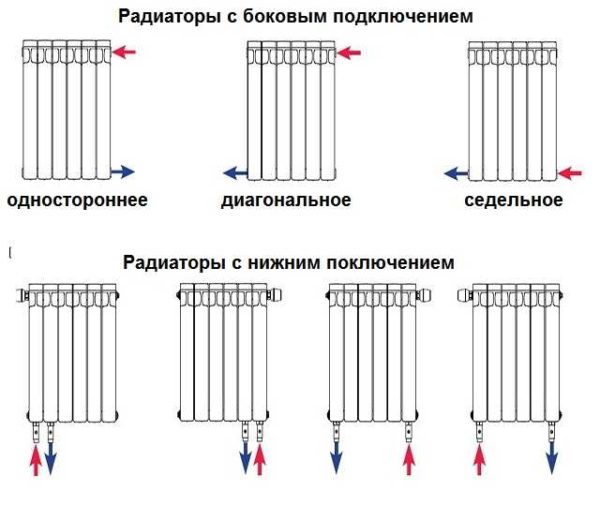

If you install radiators with the bottom connection, you have no choice. Each manufacturer rigidly binds the supply and return, and its recommendations must be strictly followed, since otherwise you simply will not get heat. There are more options with side connection (more details about them are written here).
Strapping with one-way connection
One-way connection is most often used in apartments. It can be two-pipe or one-pipe (the most common option). In apartments, metal pipes are still used, therefore, we will consider the option of tying the radiator with steel pipes on squeegees. In addition to pipes of a suitable diameter, two ball valves, two tees and two squeegees are needed - parts with external threads at both ends.
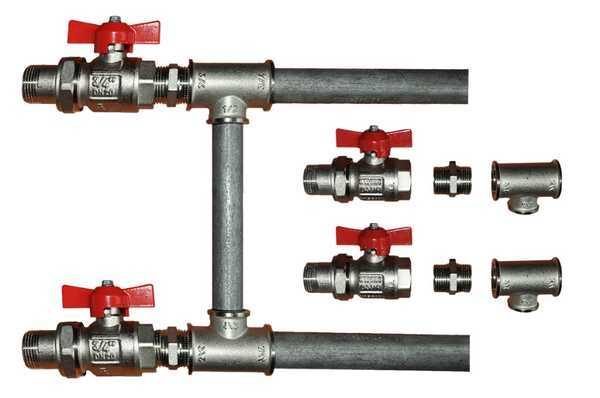

Lateral connection with bypass (one pipe system)
All this connects as shown in the photo. With a one-pipe system, a bypass is mandatory - it allows you to turn off the radiator without stopping or lowering the system. You cannot put a crane on the bypass - you will block the movement of the coolant along the riser with it, which is unlikely to please your neighbors and, most likely, will be fined.
All threaded connections are sealed with fum tape or linen tape, on top of which packing paste is applied. When screwing the tap into the radiator manifold, a lot of winding is not required. Too much of it can lead to the appearance of microcracks and subsequent destruction. This is true for almost all types of heating devices, except for cast iron. When installing all the others, please, no fanaticism.
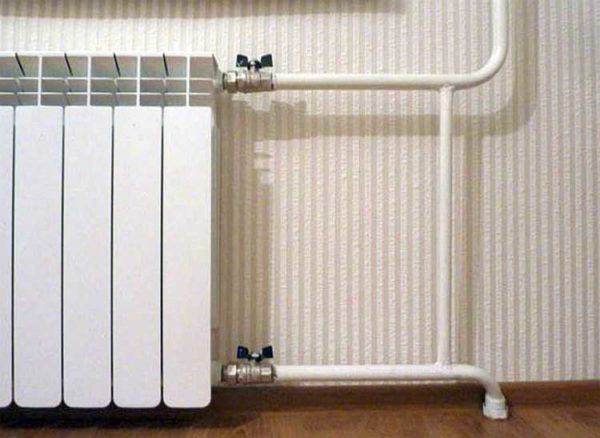

Welded option
If you have the skills / ability to use welding, you can weld the bypass. This is how the piping of radiators in apartments usually looks.
With a two-pipe system, a bypass is not required. The supply is connected to the upper input, the return is connected to the lower one, taps, of course, are needed.
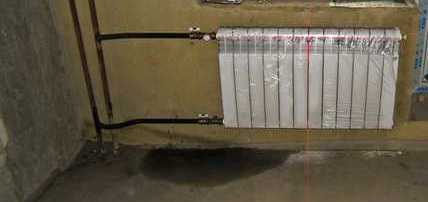

One-sided piping with two-pipe system
With lower wiring (pipes are laid on the floor), this type of connection is done very rarely - it turns out to be inconvenient and ugly, it is much better in this case to use a diagonal connection.
Strapping for diagonal connection
Installation of heating radiators with diagonal connection is the best option in terms of heat transfer.She is the highest in this case. With the lower wiring, this type of connection is easy to implement (example in the photo) - supply from this side at the top, return from the other at the bottom.
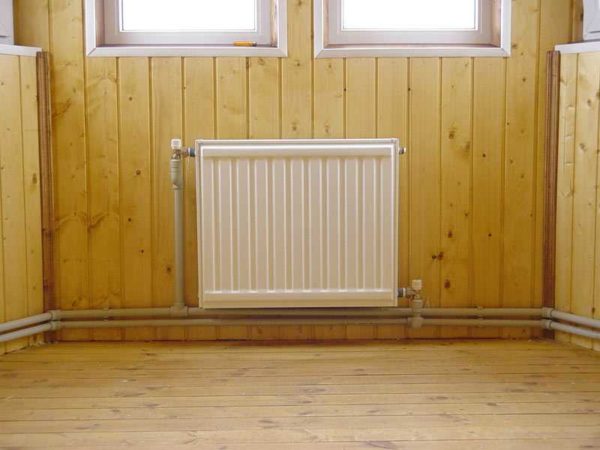

A single-pipe system with vertical risers (in apartments) doesn't look so good, but people put up with the higher efficiency.


Coolant supply from above
Note that with a one-pipe system, a bypass is again required.
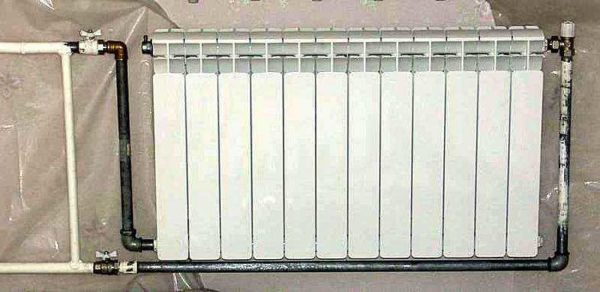

Coolant supply from below
Saddle connection
With lower wiring or hidden piping, installing heating radiators in this way is the most convenient and most inconspicuous.
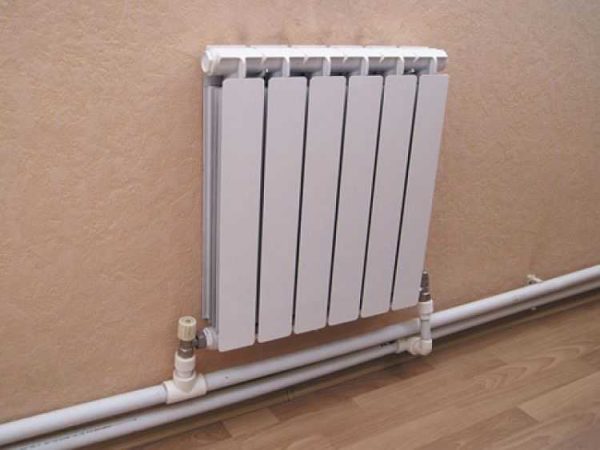

With saddle connections and bottom one-pipe wiring, there are two options - with and without bypass. Without a bypass, the taps are still installed, if necessary, you can remove the radiator, and install a temporary jumper between the taps - a squeeze (a piece of pipe of the required length with threads at the ends).
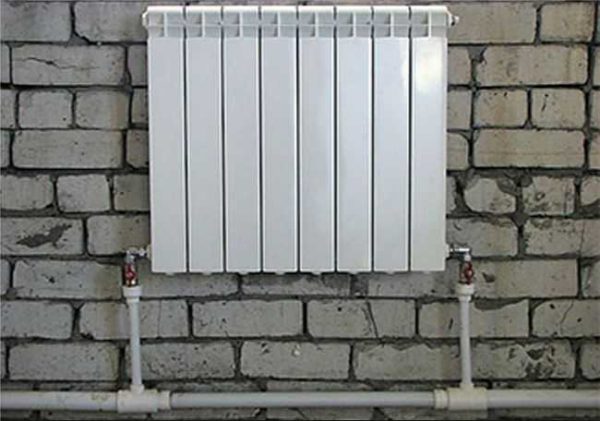

Saddle connection for one pipe system
With vertical wiring (risers in high-rise buildings), this type of connection can be seen infrequently - heat losses are too large (12-15%).
What you need to consider when building batteries (radiators) heating
The thermal energy of the batteries from the radiators must create such a heat flux in order to compensate for the inevitable energy losses outside the room and to provide the required set comfortable temperature in it, usually 18 -21 degrees above zero.
If the temperature of the batteries is acceptable, but still in the apartment, the house is cold, then battery build-up cannot be avoided. The excursion below will probably help a certain category of people understand what should be done in such cases.
Probably even housewives know that heating pipes in rooms are divided into "return" and supply pipes. Naturally, there will be no result if the batteries are built up from the "return" side. To do this, they will need at least one and a half times more than if they are included in the supply pipe, since they are much colder in the "return" than those included in the supply of the coolant.
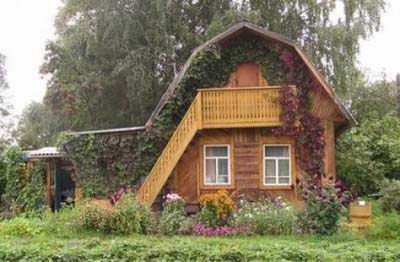

What is useful to know about heating radiators (batteries)? The ordinary "classic" cast-iron section of the battery develops a power of 0.1 kW at a surface temperature of 70 degrees. It remains to ask, how often have we felt such a temperature on the surface of the battery?
So, you have built up the batteries, the rooms have become warmer, but that's bad luck. The consumption of heat energy has gradually increased and you have noticed (if you have a meter) that you have to pay more for heat (gas).
Many people wonder why the radiators are hot at the top and much colder at the bottom? Instead of being sad, in this case it is better to be happy. The battery in this case gives off heat well, but with one but ... But, the fact is that the reason for the coolness below is not trivial dirt, when the battery has not been washed for years and decades. In residential buildings of housing and communal services, this procedure is practically not carried out, despite the increasing requirements for the need to flush the heating facilities of residential buildings from the side of heating network enterprises. When flushing, old deposits are shaken under high pressure using a compressor, and then batteries and pipes are also flushed with a solution containing hydrochloric acid.
If you have your own home, then you can not badly flush the batteries by filling the system with water with the addition of a drainage agent containing hydrochloric acid components (such a tool is not easy to find on the market, most of them are based on alkali). At the same time, you can drive the suspension with a circulation pump, and if it is not there, then let the water infuse, then drain it (of course, taking care of the environment) and rinse the system with running water until clarification.
In summer, a Mayevsky pendulum should be installed in radiators to bleed air, and valves should be installed in each room on the radiators to temporarily shut off the coolant supply in order to regulate the heat supply, when utilities choose consumption limits in April and the radiators are hot as in winter. Valves are also needed for the possibility of minor repairs. When choosing heating radiators, you need to know that a steel and aluminum battery is much more efficient (warmer) than a cast iron one. True, there is a widespread opinion that ordinary network water will destroy such a battery faster.But this is a separate story, although there is no smoke without fire.
Video tutorials on installing heating radiators
There is a need to install an additional heating radiator. It is necessary to coordinate with the Criminal Code. But they preliminarily refuse, without really substantiating anything. The type of excess heat consumption is not included. What is the PERMISSION from the Criminal Code? How to put pressure on the Criminal Code? What should be the "real" arguments for refusing to install an additional radiator.
You need to find out the thermal power in watts of those radiators that are installed in your apartment by the developer. The number of radiators and the amount of heat transfer must correspond to the design heating power of your apartment - let the UK show you these standards. If the numbers match, you will not be allowed to remove additional Watts from the riser. If the real nameplate heat transfer capacity of your radiators is in total, and at the planned temperature of the coolant is less, then feel free to ask for permission to install an additional radiator .. Example: let's say your square. without a loggia - 60 m2. Multiply 60 by a height of 2.7m - we get 162m3. Now we multiply 162m3 by the Standard (41kW per 1 m3), and we get 6,642W of the standard amount of heat that the UK should provide you.
You need to find out the thermal power in watts of those radiators that are installed in your apartment by the developer. The number of radiators and the amount of heat transfer must correspond to the design heating power of your apartment - let the UK show you these standards. If the numbers match, you will not be allowed to remove additional Watts from the riser. If the real nameplate heat transfer capacity of your radiators is in total, and at the planned temperature of the coolant is less, then feel free to ask for permission to install an additional radiator .. Example: let's say your square. without a loggia - 60 m2. Multiply 60 by a height of 2.7m - we get 162m3. Now we multiply 162m3 by the Standard (41kW per 1 m3), and we get 6,642W of the standard amount of heat that the UK should provide you.
Types of radiators
Bimetallic... The structure has elements made of different metals. There are pairs of aluminum-copper and aluminum-steel. A good solution for an apartment. They have the highest heat transfer among other types of radiators. They are easy to install, have a high working pressure - 35 atm. They are relatively expensive.
Aluminum radiators relatively easy to install, they have good heat dissipation. Working pressure - up to 18 atm., Which makes it possible to install in high-rise buildings. Almost corrosion resistant. Not installed if pipes are made of copper, as this metal reacts with aluminum, which will destroy both the pipe and the device.
Cast iron are common in old houses of small number of storeys due to the low operating pressure of max 12 atm. Not very suitable for apartments, since, firstly, they are heavy, which makes the installation process difficult. The units heat up slowly and cool down slowly, making it difficult to adjust the room temperature. On the other hand, these devices do not react with the coolant and are durable.
Steel... Inexpensive solution for multi-storey apartment buildings. They rust quickly, so the service life is short - 15-25 years. But they are easy to install. Compatible with any pipes. There is no possibility of building up with additional sections.
Installation of heating radiators in an apartment
Exist special regulations on the installation of thermal radiators. They are spelled out in SNiP. The device must withstand the pressure of the coolant in the heating system
The metal from which the radiator is made should not be combined with the pipes of the system galvanic couples... This happens, for example, when aluminum and copper interact. The reaction of such a compound will lead to corrosion.
Distance between the appliance and the protruding part of the window sill should be 10 cm... If this figure is less than 75% of the depth of the radiator, it will be difficult to release the heat flow.
There must be a gap of at least 10 cm and no more than 15 cm between the bottom edge of the device and the floor. ineffective and slow, and with a large one, there will be a strong temperature drop along the height of the room.
If the device is installed not under a window, but near a wall, the distance between these two surfaces is not less than 20 cm.
Radiator location
The thermal device is installed in such a way that its heat transfer is maximally effective.
Best place - under the windows, since it is through them that the greatest heat losses occur. If the room has an external cold wall, additional radiators are installed on it.
Pipes in the heating system:
- Steel tubes are traditionally installed in high-rise apartment buildings. They tolerate high pressure and temperature. Corroded.
- Reinforced plastic began to be used when laying a heating system recently, but they have already become popular. Convenient when installing radiators.
- Polypropylene pipes are also popular. Ease of installation is due to the possibility of permanent connection by means of the diffusion welding method.
- Polyethylene pipes although they are not often used due to a somewhat high price and a small area of application. The latter is due to the design feature, or rather, the bending radius.
- Copper - a rare solution due to the high cost and high requirements for the coolant. Installed only in private houses.
Fittings
Accessories include auxiliary elements. The Mayevsky valve is designed to bleed air or other gases from the radiator. The presence of air in the heater is called "air bag". It can cause the radiator to malfunction.
There are also reflective screens on sale, which are mounted on the wall behind the heating device, designed to reduce heat loss... Evaporators on the radiator that maintain the humidity in the room. Fans that are installed on the device itself in order to increase heat transfer and dryers.
What interferes with efficient heating?
The room can be cold, not only because of the poor performance of the device, but also because of the obstacles that the person himself sets. Heat dissipation decreases if a:
- the radiator is covered with long curtains;
- the device is covered with upholstered furniture;
- there are protruding window sills;
- decorative grilles are located on top.
Installing a new battery
We will analyze the simplest case - the installation of a new heating device in place of the old cast-iron sections with the same center-to-center distance of the connections (see also replacement of heating batteries). We have to put the battery with our own hands without any alteration of the liner, without the inclusion of polymer and metal-polymer sections.
What is the reason for the choice of this particular scenario?
- We chose the bimetallic radiator, if you remember, precisely for its strength and ability to withstand off-design pressure and water hammer. The use of much weaker mechanically pipes and fittings will deprive our venture of all meaning.
- Welding work on a sealed connection of the liner requires a certain skill. It seems that a specialist capable of performing this work does not need advice aimed at beginners.
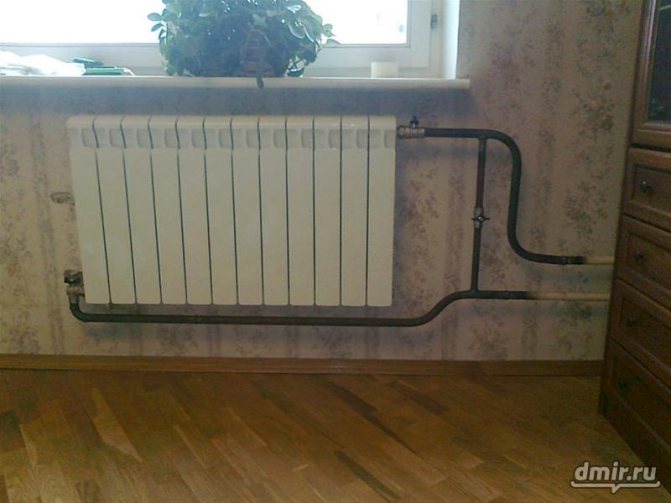

Here, the eyeliner was digested from the divorced under the convector. The connection is made in such a way that the radiator does not need to be flushed. But the Mayevsky crane is desirable
How is the actual installation of a new radiator in an apartment carried out?
- The radiator without plugs is hung on the brackets. If necessary, they are bent in any direction using a lever - a piece of pipe.The axes of the end of the radiator must exactly correspond to the axes of the connections; the heater itself is set strictly according to the level.
- Then, with the radiator removed from the brackets, locknuts and plugs - adapters are sequentially driven onto the threads of the supply line.
- The radiator is re-hung on the bracket; then the lead-through plug is screwed into the radiator so that about a centimeter of open thread remains between it and the radiator housing.
- The thread is wound along the thread. The best roll-up is plumbing flax with paint: you put a little paint on the bare thread and over the roll-up; when you tighten the cork, the flax is soaked evenly.
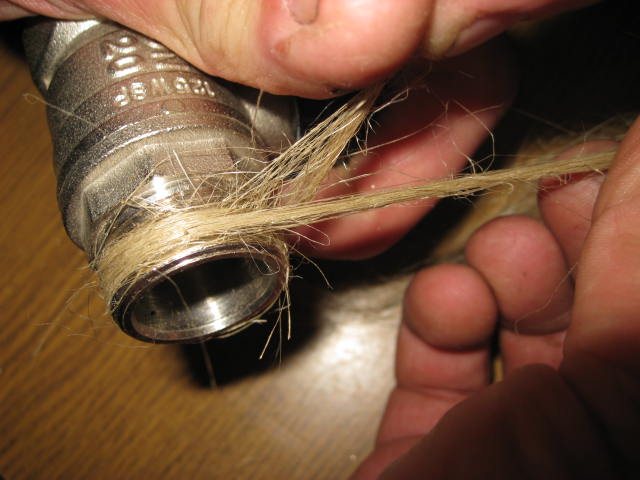

A thin strand of flax is wound along the thread.
Helpful: a small amount of paint will inevitably squeeze out onto the edge of the cork. So that it does not catch the eye, it is better to take the paint to match the radiator.
- Then the plug is tightened with moderate effort; the same operation is repeated for the locknut.
- After the batteries are mounted, be sure to fill the risers and carefully inspect the threads and the devices themselves for leaks. It is clear that the pressure and temperature will not be equal to the operating pressure; however, all serious flaws will come out.
If the batteries are changed in winter, at the height of the season, when starting the risers, it is better to have any means of communication with you that allows, in the event of a serious leak, to dump the risers immediately, without wasting time on going up to the apartment and back down.
By the way: plumbers in such cases simply knock on the riser, having stipulated the agreed signals. The sound is perfectly transmitted through several overlaps.

